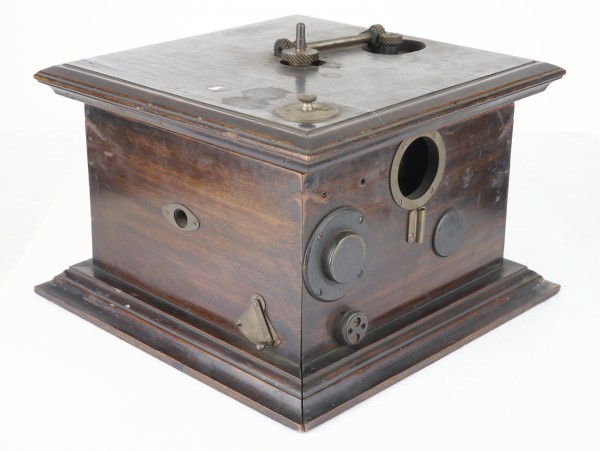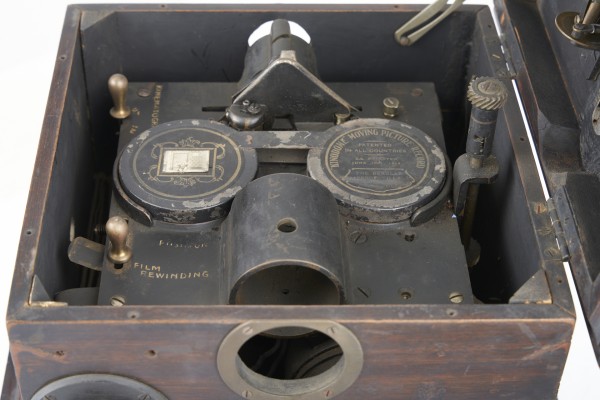A short-lived, early amateur film format which utilized 6mm-wide, horizontally transported nitrate reduction prints, housed in metal cartridges.
Film Explorer

The only-known extant Kinodome Moving Picture Record: “Part Two” of the 1912 La villa aux surprises (titled The Burglar Proof Villa on the cartridge). The film is 6mm wide (0.236 in), with semicircular notches along its edge instead of perforations. The frames are oriented horizontally – the film was transported horizontally across the gate.
George Eastman Museum, Rochester, NY, United States.
Identification
7mm x 5mm (0.256 in x 0.197 in).
Semicircle notches
B/W
None
1
Silent
8mm x 6mm (0.315 in x 0.236 in).
B/W
Unknown
History
The Kinodome Motion Picture Record, and the device designed to play it, constitute a short-lived amateur moving image system that may have been only briefly, if ever, marketed to the public. With one projector and film known to exist, no known advertisements and scant references to its patents in contemporary trade journals, attempting to draw any hard conclusions about the format is a difficult endeavor.
However, there are some verifiable facts. Both components of the cinematographic apparatus were patented by Ferdinand von Madaler, an inventor and engineer born in the Austro-Hungarian Empire, whose first experiments were carried out in Budapest. Von Madaler spent his lifetime innovating sound and film devices for companies across Europe and the United States. Many of his inventions focus on utilizing small-scale machinery, or projecting small images – this affinity naturally suited the creation of film formats for the amateur market. After moving first to France and then London, in 1906, von Madaler worked for a number of businesses, including his own Neophone Recording Company, and for a subsidiary of the German Neue Photographische Gesellschaft, the Rotary Photographic Company, which primarily produced silver bromide postcards and stereo cards for the mass-consumer market. It was for the Rotary Photographic Company that von Madaler filed patents detailing a film cartridge and projector system, in 1912 and 1914, respectively. Utilizing a 6mm film, drawn horizontally by means of edge notches from one circular metal hub to the other. The cartridge and projector were quite unlike any other film systems being produced at the time. Though the design of the projector and cartridge indicate that they were intended for the amateur market, the surviving film is recorded on flammable nitrate stock. The use of nitrate stock for the amateur market was a practice that would soon become frowned upon. In a 1912 letter to Thomas Edison, George Eastman called the use of nitrate for amateur home projectors “wholly indefensible and reprehensible” (Coe, 1981, p. 164). The Rotary Photographic Company was dissolved in 1916, during World War I, and although von Madaler’s initial patent of the film carrier was covered by The Bioscope, existing evidence – or, rather, the lack of it – suggests the Kinodome was never sold or marketed to consumers. (Anon., 1912)
In 1915, soon after his collaboration with the Rotary Photographic Company, Ferdinand von Madaler and his wife Katharina (an inventor herself, with multiple patents related to pairing recorded sound with moving images) emigrated to the United States where they would spend the remainder of their lives. Von Madaler continued to patent numerous innovations in the decades following the brief life of Kinodome, including many experiments with talking pictures. (Anon., 1947)
Selected Filmography
An incomplete copy with the English title The Burglar Proof Villa is conserved at the George Eastman Museum, Rochester, NY, United States.
An incomplete copy with the English title The Burglar Proof Villa is conserved at the George Eastman Museum, Rochester, NY, United States.
Technology
The projector for the Kinodome Motion Picture Record is a cuboid wooden cabinet with a top that flips open, revealing the mechanics inside. The extant device, which is missing its lens and light source, is operated by hand crank and includes an electrical outlet for the bulb. Mechanics contained in the projector lid indicate that the device may have been built to play records along with the film cartridges – in 1915, von Madaler applied for a patent for a similar-looking “Cinematograph and Gramophone Machine”, and since many of his later patents focused on combining sound and film, it is not unlikely that he was attempting to do so here.
The Kinodome film cartridge consists of two circular metal housings with a metal band across the top connecting them. The 6mm film is attached at both ends to an inner hub in each cartridge, and passes through the open center space, where the projector’s frame advance mechanism made contact with the film’s semicircular edge notches. The horizontal film advancement, along with the attendant horizontal frame orientation, distinguishes Kinodome from many other film systems. A photographic frame enlargement is attached to the upper face of the cartridge – in addition to the film title – intended to give a preview of the projected film’s content.

From the outside, the Kinodome projector’s appearance was similar to that of a phonograph – many of Ferdinand von Madaler’s other patents around this time involved attempts to pair moving images with sound.
Technology Department, George Eastman Museum, Rochester, NY, United States. Photographed by Ira Srole.

A Kinodome Moving Picture Record. Based on the one surviving example, Kinodome films were likely reduction-printed down from 35mm films.
References
Anon. (1912). “Latest Inventions”. The Bioscope, 16:2 (July 11): p. 111.
Anon. (1947). “Von Madaler, Inventor, Dies After Celebration”. The Los Angeles Times (Nov. 11): p. 24.
Antipodean (n.d.). “Four Rotary Photographic Series Postcards of British Actresses”. https://www.antipodean.com/pages/books/17031/four-rotary-photographic-series-postcards-of-british-actresses (accessed Mar. 14, 2025).
Coe, Brian (1981). The History of Movie Photography. Westfield, NJ: Eastview Editions.
Early Photography (n.d.) “Company Details”. http://www.earlyphotography.co.uk/site/companies.html (accessed Mar. 14, 2025).
Gütgemann-Holtz, Wilma & Wolfgang Holtz (eds) (2009), Neue Photographische Gesellschaft Steglitz: Die geschichte eines vergessenen Weltunternehmens (1897–1921). Berlin: Eigen.
Old Bailey Proceedings Online (2023). “Trial of SCHEIBE, Otto (40, engineer), KNIGHT, Frederick (36, clerk), BLAU, Gustav (20, fitter) (t19060911-105)”. https://www.oldbaileyonline.org/record/t19060911-105 (accessed Mar. 14, 2025).
Patents
Rotary Photographic Co, Ltd, and Ferdinand von Madaler. Improvements in Holders for Cinematograph or like Films and in Films for use therewith or similar Apparatus. British patent 12,538, filed May 24, 1911, and issued May 24, 1912.
Rotary Photographic Company Limited and Ferdinand von Madaler. Improvements in Motion Picture and like Apparatus. British patent 10,273, filed April 30, 1912, and issued August 1, 1912.
Madaler, Ferdinand von. Film Carrier. US patent 1,100,591, filed May 18, 1912, and issued June 16, 1914. https://patents.google.com/patent/US1100591A
Madaler, Ferdinand von. Opticopictorial Apparatus. US patent 1,139,241, filed April 24, 1913, and issued May 11, 1915. https://patents.google.com/patent/US1139241A
Madaler, Ferdinand von. Cinematograph and Gramophone Machine. US patent 1,230,633, filed June 22, 1915, and issued June 19, 1917. https://patents.google.com/patent/US1230633A
Compare
Related entries
Author
Kirk McDowell is a film archivist interested in short-lived and experimental amateur film systems. As Assistant Collection Manager in the Moving Image Department of the George Eastman Museum, he helps care for over 100,000 reels in the archive’s collection, facilitates donations, handles nitrate and safety shipments and teaches small-gauge film inspection. He is a 2018 graduate of the L. Jeffrey Selznick School of Film Preservation and has previously held positions at the National Audio-Visual Conservation Center, Library of Congress, and the Wisconsin Center for Film and Theater Research.
McDowell, Kirk (2025). “Kinodome Moving Picture Record”. In James Layton (ed.), Film Atlas. www.filmatlas.com. Brussels: International Federation of Film Archives / Rochester, NY: George Eastman Museum.


